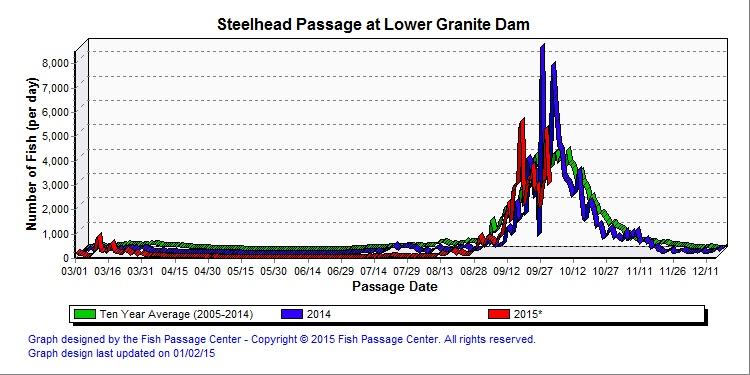forum
library
tutorial
contact

While Smaller,
B Run Remains on Course
Eric BarkerLewiston Tribune, October 2, 2015
|
the film forum library tutorial contact |

|
While Smaller,
Eric Barker |
IDFG says it won't impose size restrictions on Clearwater River steelhead angling
 The Oct. 15 opening of the Clearwater River to catch-and-keep steelhead fishing won't include size restrictions designed to protect the B-run fish the river is famous for.
The Oct. 15 opening of the Clearwater River to catch-and-keep steelhead fishing won't include size restrictions designed to protect the B-run fish the river is famous for.
Joe DuPont, regional fisheries manager for the Idaho Department of Fish and Game at Lewiston, said the run, which is coming in much lower than a preseason forecast, appears to be strong enough to support harvest without threatening hatchery spawning.
"We will not have to implement any rule changes for the steelhead harvest opener," he said. "It will remain as it has for some time - a daily limit of two adipose-clipped steelhead with no size restrictions."
The department considered limiting harvest to hatchery fish less than 28 inches long. Doing that would protect the larger B-run steelhead and ensure enough return to hatcheries to support spawning needs in the spring.
In 2013, which also saw a poor return of B-run steelhead to the Clearwater, the department adopted rules that required anglers to release hatchery steelhead longer than 28 inches. But DuPont said this year's run is looking better than the run two years ago and the department has expanded its ability to collect hatchery steelhead for spawning.
In 2013, the department collected almost all its broodstock at Dworshak National Fish Hatchery. Now the department is able to collect steelhead that return to the South Fork of the Clearwater River.
As of Sunday, the steelhead run was estimated to be about 80 percent complete at Bonneville Dam on the Columbia River where about 14,500 hatchery steelhead bound for the Clearwater River have been counted. Of those, about 4,600 are steelhead that have spent at least two years in the ocean.
In 2013, only about 2,800 B-run steelhead from Dworshak National Fish Hatchery were counted at Bonneville. Hatcheries need about 2,000 to meet spawning needs.
"We still have more coming and we are already quite a bit above (2013), and we also collect more brood on the South Fork and the South Fork run is tracing right along with previous years."
learn more on topics covered in the film
see the video
read the script
learn the songs
discussion forum
